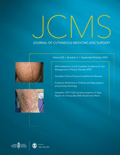
Dermatology Reports
Scope & Guideline
Pioneering research for transformative dermatological practices.
Introduction
Aims and Scopes
- Clinical Management of Dermatological Conditions:
The journal highlights effective management strategies for various skin disorders, including atopic dermatitis, hidradenitis suppurativa, psoriasis, and more, emphasizing evidence-based practices. - Innovative Treatments and Therapies:
A core focus is on novel treatment approaches, including biologics, immunotherapy, and regenerative medicine, aimed at improving patient outcomes in dermatological care. - Integration of Technology and AI in Dermatology:
Dermatology Reports explores the role of artificial intelligence and teledermatology in enhancing diagnostic accuracy and patient accessibility to care. - Patient Safety and Quality of Care:
The journal addresses critical issues related to patient safety in dermatological settings, ensuring high standards of care and management practices. - Research on Allergic Reactions and Dermatitis:
Research exploring the mechanisms, diagnosis, and management of allergic contact dermatitis and other hypersensitivity reactions is consistently featured.
Trending and Emerging
- Artificial Intelligence and Digital Health:
Recent publications increasingly explore the applications of artificial intelligence in diagnostics, treatment planning, and improving healthcare equity, indicating a significant trend towards integrating technology in dermatology. - Focus on Pediatric Dermatology:
There is a growing emphasis on pediatric dermatological issues, such as atopic dermatitis and skin allergies in children, highlighting the need for specialized care in this demographic. - Comorbidities and Multidisciplinary Approaches:
Research on the interplay between dermatological conditions and comorbidities is gaining traction, emphasizing the importance of holistic and multidisciplinary management strategies. - Research on Wound Healing and Regenerative Medicine:
Emerging studies focus on innovative approaches to wound healing, including the use of stem cells and advanced therapies, reflecting a trend towards regenerative treatments in dermatology. - Teledermatology and Remote Care Solutions:
The impact of teledermatology, especially post-COVID-19, is increasingly recognized as vital for improving access to care, showcasing a shift towards remote healthcare solutions.
Declining or Waning
- Traditional Treatments for Common Skin Conditions:
There is a noticeable decrease in publications focusing on conventional treatments for common dermatological issues, as newer therapies and approaches gain attention. - Generalized Dermatology Reviews:
Papers providing broad overviews of dermatological practices without a specific focus on recent advancements or specific conditions are less frequent. - Historical Perspectives on Dermatology:
Research that delves into historical practices or retrospective analyses of past treatments is becoming less emphasized, with a shift towards current and future-focused studies.
Similar Journals

World Allergy Organization Journal
Connecting Global Research for Better Allergy CareWorld Allergy Organization Journal is a premier open-access publication dedicated to advancing the understanding and treatment of allergic diseases and related conditions. Published by ELSEVIER, this journal boasts a commendable impact factor and ranks in the second quartile for both Immunology and Allergy, as well as the first quartile in Pulmonary and Respiratory Medicine. Since its inception as an open-access journal in 2008, it has consistently aimed to provide a credible platform for researchers, clinicians, and students to disseminate original research, reviews, and clinical studies. With its emphasis on high-quality scholarship and practical applications, the World Allergy Organization Journal plays a crucial role in bridging theoretical knowledge with clinical practice, making significant contributions to the fields of immunology, allergy, and respiratory medicine. The journal is particularly notable for its accessibility to a global audience, exemplified by its open-access model since 2008, promoting a wider exchange of ideas and innovations across borders.

CLINICAL AND EXPERIMENTAL DERMATOLOGY
Unlocking New Horizons in Skin Disorder Research.CLINICAL AND EXPERIMENTAL DERMATOLOGY is a prominent journal in the field of dermatology, published by Oxford University Press. With an ISSN of 0307-6938 and an E-ISSN of 1365-2230, this journal has been a vital resource for researchers and practitioners since its inception in 1976. Recognized as a Q2 journal within the category of dermatology for 2023, it holds a respectable position, ranking #54 among 142 journals in this discipline, placing it in the 62nd percentile on Scopus. The journal is dedicated to publishing high-quality research that spans clinical and experimental aspects of dermatological science, making it an essential source of knowledge for advancing understanding and treatment of skin disorders. Although it operates on a traditional subscription model without open access options, its contributions to the field are significant, influencing both clinical practices and academic research. Researchers, clinicians, and students alike will find vital insights and contemporary themes presented in its pages, supporting ongoing education and innovation in dermatology.

JOURNAL OF DERMATOLOGY
Illuminating the path to dermatological excellence.The Journal of Dermatology, published by Wiley, is a premier academic journal dedicated to advancing the field of dermatology, with its esteemed reputation reflected in its Q1 ranking in Dermatology and a remarkable Q2 ranking in Miscellaneous Medicine as of 2023. Since its inception in 1974, the journal has become a vital resource for researchers, clinicians, and students alike, covering pioneering studies and cutting-edge advancements in skin health and disease. With a Scopus rank of #32 out of 142 in the Dermatology category, placing it in the 77th percentile, the journal underscores its commitment to fostering knowledge and innovation within the dermatological community. Although the journal operates under a subscription model, it remains an essential platform for disseminating impactful research that shapes clinical practice and enhances patient care. For anyone invested in dermatological sciences, Journal of Dermatology serves as a key publication where critical insights and developments are regularly showcased.

DERMATOLOGY
Pioneering research, transforming skin health.DERMATOLOGY, an esteemed journal published by KARGER, is a vital resource in the field of dermatological research and clinical practice. Established in 1893, with its comprehensive coverage extending to 2024, this journal has earned its place as a leading publication, holding a prestigious Q1 quartile ranking in Dermatology and ranking 15th out of 142 in the Scopus Medicine - Dermatology category, reflecting its 89th percentile standing within the discipline. The journal aims to disseminate innovative research findings, critical reviews, and clinical studies that advance the understanding of skin disorders and their treatments. While primarily available through institutional subscriptions, DERMATOLOGY remains committed to enhancing accessibility and fostering international collaboration among researchers, professionals, and students in the dermatological community. Its rigorous peer-review process guarantees the highest quality of published works, making it an essential reference for those dedicated to advancing dermatological science and improving patient care.

BLOOD REVIEWS
Elevating knowledge in blood disorders and cancer care.BLOOD REVIEWS is a highly regarded journal published by Churchill Livingstone, specializing in the fields of Hematology and Oncology. With an impressive Q1 ranking in both disciplines and placing in the top 10% of its peer categories according to Scopus metrics, it provides an essential platform for the dissemination of cutting-edge research and reviews pertaining to blood disorders and cancer treatment. Since its inception in 1987 and continuing through 2024, the journal has established itself as a cornerstone for healthcare professionals, researchers, and students who seek to advance their understanding of hematologic and oncologic topics. While not an open-access journal, BLOOD REVIEWS retains a reputation for delivering high-quality, peer-reviewed articles that foster dialogue and innovation within the scientific community. For those in the United States and beyond, the journal serves as a vital resource, housed at the Journal Production Department in Edinburgh, Scotland, ensuring accessibility and a global reach in its critical academic contributions.

JOURNAL OF CUTANEOUS MEDICINE AND SURGERY
Advancing knowledge in skin health and surgical excellence.The Journal of Cutaneous Medicine and Surgery is a premier publication in the fields of dermatology and surgery, dedicated to advancing the scientific understanding of skin-related conditions and surgical techniques. Published by SAGE Publications Inc, this esteemed journal features a rich repository of peer-reviewed research, reviews, and clinical studies, ensuring that it remains at the forefront of dermatologic and surgical innovation. With an impressive impact factor and a ranking in the top quartile (Q1) of both dermatology and surgery categories for 2023, it is recognized as a vital resource for professionals, researchers, and students alike. The journal has consistently made significant contributions to the knowledge base that guides clinical practice and surgical decision-making, fostering a deeper understanding of the complexities involved in cutaneous medicine. For comprehensive updates, researchers can access this journal through SAGE’s platform, which supports the dissemination of high-quality research findings to a global audience.

CUTIS
Championing excellence in skin health education.CUTIS is a distinguished journal devoted to advancing the field of dermatology and related medical disciplines. Published by Quadrant HealthCom Inc, this journal has been a critical resource since its inception in 1970, traversing the landscape of skin health and medical practice through its engaging articles and research. With an ISSN of 0011-4162 and an E-ISSN of 2326-6929, CUTIS is indexed in Scopus, where it currently holds a rank of #101/142 in the Dermatology category, placing it in the 29th percentile, further affirming its relevance within the academic community. Although it is classified within the Q3 quartile in both Dermatology and Medicine (miscellaneous), CUTIS remains committed to publishing high-quality research that encompasses both innovative treatments and essential dermatological knowledge. The journal serves as an invaluable platform for researchers, practitioners, and students alike, providing critical insights and fostering discussions that enhance patient care and professional practice in the dermatology field.

BRITISH JOURNAL OF DERMATOLOGY
Advancing dermatological excellence since 1892.The British Journal of Dermatology, published by Oxford University Press, stands as a premier platform for advancing the field of dermatological research and clinical practice since its inception in 1892. With a strong commitment to disseminating high-quality research, this esteemed journal is currently ranked in the Q1 category for both Dermatology and Miscellaneous Medicine in 2023, reflecting its influential position in the academic landscape. As the leading journal in its field, it enjoys a robust Scopus ranking of #1 out of 142 in dermatology, placing it in the 99th percentile globally. The journal covers a wide scope of subjects pertinent to dermatology, including clinical trials, treatment innovations, and epidemiological studies, making it an essential resource for researchers, healthcare professionals, and students alike. Although it is not an open-access publication, it ensures a broad reach through institutional subscriptions, fostering knowledge exchange across the global dermatological community. Based in the heart of the United Kingdom, the British Journal of Dermatology continues to play a crucial role in shaping the future of skin health and disease management.

Annals of Dermatology
Elevating dermatology with impactful research.Annals of Dermatology is a prestigious academic journal published by the Korean Dermatological Association, focusing on the latest research and advancements in the field of dermatology. With a commitment to advancing knowledge in skin health and disease, this journal serves as a vital resource for researchers, clinicians, and students working in dermatology and related disciplines. Since its inception in 1989, it has evolved to consolidate its position in the academic community, boasting a Q2 ranking in the 2023 Dermatology category and a Scopus rank of #87 out of 142, placing it in the 39th percentile. Although it operates under a subscription model, the journal's impact factor reflects its significance in advancing dermatological research, attracting innovative studies and reviews that shape clinical practice. With a publication history extending from 1989 to 1996 and then from 2008 to the present, Annals of Dermatology continues to be an essential publication for those devoted to improving skin health.

AMERICAN JOURNAL OF CLINICAL DERMATOLOGY
Bridging Research and Practice in DermatologyThe American Journal of Clinical Dermatology, published by Adis International Ltd, is a leading peer-reviewed journal dedicated to advancing the field of dermatology. With a notable impact factor and a prestigious Q1 rank in both Dermatology and Miscellaneous Medicine categories, this journal stands out as a valuable resource for researchers and clinicians alike, offering cutting-edge insights into clinical practice and innovative treatment strategies. Its comprehensive scope encompasses a broad range of topics within dermatology, addressing both common and rare conditions, with a focus on emerging therapies and technologies. As it converges its publication years from 2000 to 2024, the journal remains an essential platform for disseminating high-quality research to professionals striving to improve patient care and outcomes. With the ISSN 1175-0561 and E-ISSN 1179-1888, the American Journal of Clinical Dermatology facilitates greater accessibility to pivotal findings within the field, making it an indispensable resource for anyone involved in dermatological research and practice.